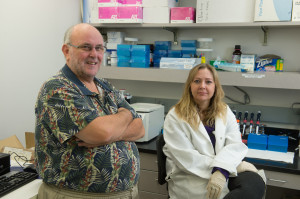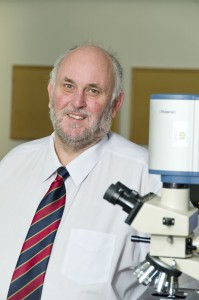They came from near and far — from Seattle and Ohio and the UK — and they wore academic regalia and suits, soccer jerseys and blue jeans. There was laughter, there were smiles and hugs, and a few tears were shed, too.
They came together to honor the life of Colorado State University Distinguished Professor Ian Orme on Sept. 28 at the Lory Student Center.
Orme, who was one of the world’s leading experts in tuberculosis and immunology, passed away peacefully in his sleep June 19, while at his summer home in upstate New York.
University Distinguished Professors and select members of the academic faculty at CSU in full regalia started off the memorial with a processional.
CSU President and Chancellor Tony Frank said the tribute by academic leaders was meant to honor Orme’s position as a University Distinguished Professor, the highest academic recognition awarded by the University.
Orme was one of the world’s leading experts in tuberculosis and immunology. He shaped the scientific understanding of tuberculosis in myriad ways, including pioneering the mouse and guinea pig models used around the world for tuberculosis research.
He was one of only two actively serving University Distinguished Professors to pass away since the designation was created at CSU. University Distinguished Professor of Chemistry John Stille died in a plane crash in 1989.
Orme is survived by his wife, Eileen, and his sons, Joseph Allen Michael Orme and Robert James Steven Orme.
He lived life to the fullest
Frank described Orme as a man of amazing intellect, which was evident in the hundreds of scientific presentations he gave over the years, the dozens of graduate students and young researchers he mentored, and the millions of dollars in competitive grant activity he generated in the realm of tuberculosis and medicine.
“As high as his intellectual standards were, he had even higher standards for living life,” said Frank. Orme also had a predilection for poking fun at authority, he added.
Patrick Brennan, a University Distinguished Professor who hails from Ireland and who studies tuberculosis and leprosy in the Department of Microbiology, Immunology, and Pathology, was a friend and colleague of Orme’s over the last 32 years. When Orme arrived at CSU, the two researchers formally established the Mycobacteria Research Laboratories, a world-renowned group that now includes 20 laboratories.
A bright star in the galaxy
Brennan said that on a personal level, he felt a sense of profound grief and sadness upon hearing the news that Orme passed away. This was a gross injustice, he declared, given Orme’s age, 65.

Brennan said that Orme was the brightest star in the department — and the galaxy. It was fitting that Dr. Tony Frank, a veterinary pathologist by training — who was mentored by Orme as a graduate student — was presiding over the memorial.
Many of Orme’s friends and colleagues first got to know the gifted and witty researcher over beers in a bar or pub. Brennan recalled meeting him at the Rodeway Inn in Bethesda, Maryland, not far from the National Institutes of Health, where they were attending a conference. Orme had delivered what Brennan described as a magnificent 30-minute presentation on his research on that day.
“While we talked that night a bit about science, we mostly talked about Ian growing up in London,” he said. They also talked about Saranac Lake, where Orme would eventually own a summer home, and English football.
It was during that meeting in Bethesda that Brennan first thought: We have to get Ian Orme on faculty at CSU. “He’s the kind of Englishman I love,” said Brennan. “He was utterly unique.”
A generous, supportive researcher
Frank read remarks from Professor Andrea Cooper of the University of Leicester and Joanne Turner, a researcher at Texas Biomedical Research Institute. Both had trained under Orme at CSU, and both women described his generosity in the workplace and support for their careers.
“Ian was the single biggest influence on my career,” wrote Cooper, who worked as a postdoctoral fellow in the Mycobacteria Research Laboratories. His legacy is established by the number of scientists who owe their success to his guidance, she added. “He gave you the space and support for finding your own voice.”
Turner described Orme’s generosity, a common theme throughout the memorial.
“He promoted our work and would ask us to speak in his place at conferences,” she said. “We would develop our own ideas in his lab and he let us take them with us when we left,” she added.
A seeker of truth
Hugh Birley, a friend from Orme’s college years in England, described him as a renaissance man. Orme formed a drama society at the college when he learned that one did not exist. He produced and directed The Real Inspector Hound, a one-act play written by Tom Stoppard. The event sold out, and was a great success. He launched a rugby team during those formative years, and he played soccer.
“I discovered that despite his impressive girth, he’d been a county sprinter, and had set school records,” said Birley. “We also discovered quickly he knew stuff about science.”
Orme was happy to share his knowledge with his college pals, but he made it clear that they needed to be serious about their studies.
“He was a sociable guy,” said Birley. “He was also open, honest, energetic and funny.”

Following graduation, Orme told his mates what he was going to do next: I’m going to go to America and become a professor.
“He might just have declared he was going to be an astronaut,” said Birley.
Orme was a success in the academic realm, and the least pretentious man he’d ever met, Birley added. “He wasn’t impressed by show; he was a seeker after the truth. And he would help anyone learn and progress if he had that power.”
One of the good ones
Birley read prepared remarks from Joe Orme, one of Ian’s sons, as they stood side-by-side, arms wrapped around each other’s shoulders. Joe described how his father would always make time for coworkers or family members in need, and for those who were “willing to learn.”
He learned the difference between what was right and wrong from his dad, and how to be a generous person.
“He was one of the good ones,” said Joe. His father started late in life to build his career, and he became a “wonderful” gentleman. “I hope to be like him someday,” he said.
Jenny Harding, who worked for Orme for 23 years at CSU, described how his lab grew fast over the years, and how the team worked and played hard.
“If you were his friend, it was for life,” she said. He was extremely organized, and fiercely loyal to his wife, Eileen. He talked often about his hopes for the boys.
Marcela Henao-Tomayo, an assistant professor at CSU, was Orme’s last graduate student. She described his pivotal role as a mentor for her, and others.
“I saw him opening doors to anyone who wanted to learn,” she said. “The only things he asked were to work hard and have fun,” Henao-Tomayo added. “He didn’t care about where we came from, what language we spoke or which gender we identified with. Everyone had a place in his lab. He will always be a guide for me.”
University Distinguished Professor Wayne McIlwraith traveled with Orme to England just weeks before he passed away. “He’s touched my life a lot, both professionally and personally,” he said.
McIlwraith said he will always remember Orme’s kindness, his sense of family, and his trueness to his friends. “I really miss him,” he said.
Randy Basaraba, a veterinarian and professor in the Department of Microbiology, Immunology, and Pathology said he owes his career to Orme’s mentoring and friendship.
“He recognized the value of pathology and what we could bring to the science.” said Basaraba, who is a scientist in the Mycobacteria Research Laboratories.